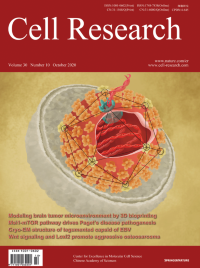
Advanced Search
Submit Manuscript
Advanced Search
Submit Manuscript
Volume 30, No 10, Oct 2020
ISSN: 1001-0602
EISSN: 1748-7838 2018
impact factor 17.848*
(Clarivate Analytics, 2019)
Volume 30 Issue 10, October 2020: 854-872
The Msi1-mTOR pathway drives the pathogenesis of mammary and extramammary Paget’s disease
Yongli Song1,2 , Christian F. Guerrero-Juarez3,4 , Zhongjian Chen5 , Yichen Tang5 , Xianghui Ma1 , Cong Lv1 , Xueyun Bi1 , Min Deng1 , Lina Bu1 , Yuhua Tian , Ruiqi Liu1 , Ran Zhao1 , Jiuzhi Xu1 , Xiaole Sheng1 , Sujuan Du1 , Yeqiang Liu5 , Yunlu Zhu5 , Shi-jun Shan6 , Hong-duo Chen7 , Yiqiang Zhao1 , Guangbiao Zhou8 , Jianwei Shuai9 , Fazheng Ren10 , Lixiang Xue11 , Zhaoxia Ying12 , Xing Dai13 , Christopher J. Lengner14 , Bogi Andersen15 , Maksim V. Plikus4 , Qing Nie3,4 , Zhengquan Yu1,*
1State Key Laboratories for Agrobiotechnology and Beijing Advanced Innovation Center for Food Nutrition and Human Health, College of Biological Sciences, China Agricultural University, Beijing 100193, ChinaMammary and extramammary Paget’s Diseases (PD) are a malignant skin cancer characterized by the appearance of Paget cells. Although easily diagnosed, its pathogenesis remains unknown. Here, single-cell RNA-sequencing identified distinct cellular states, novel biomarkers, and signaling pathways — including mTOR, associated with extramammary PD. Interestingly, we identified MSI1 ectopic overexpression in basal epithelial cells of human PD skin, and show that Msi1 overexpression in the epidermal basal layer of mice phenocopies human PD at histopathological, single-cell and molecular levels. Using this mouse model, we identified novel biomarkers of Paget-like cells that translated to human Paget cells. Furthermore, single-cell trajectory, RNA velocity and lineage-tracing analyses revealed a putative keratinocyte-to-Paget-like cell conversion, supporting the in situ transformation theory of disease pathogenesis. Mechanistically, the Msi1-mTOR pathway drives keratinocyte-Paget-like cell conversion, and suppression of mTOR signaling with Rapamycin significantly rescued the Paget-like phenotype in Msi1-overexpressing transgenic mice. Topical Rapamycin treatment improved extramammary PD-associated symptoms in humans, suggesting mTOR inhibition as a novel therapeutic treatment in PD.
https://doi.org/10.1038/s41422-020-0334-5